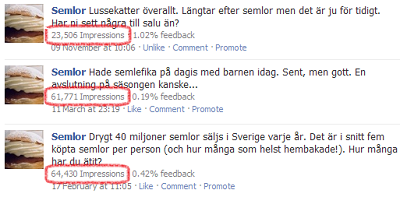Are Facebook pages half as effective as before?
Here in Sweden, we’re getting close to semlor season again, so I made my first post of the new season to my Facebook semlor page. This page is not just an outlet for my love of these tasty seasonal Swedish delights, but also my test-bed for Facebook.
Huge fall in impressions
Towards the end of last season each status update I made was receiving around about 60,000 impressions (the page had about 12,000 fans at the time).

The first post of this season earlier this week received just 23,000 impressions and the page had 13,000 fans. What’s happened? Did everyone suddenly stop using Facebook at some point during the summer?
Well, perhaps. Around a third of semlor fans though are active on Facebook at the moment, but looking at the old Facebook Page insights I can see that page views almost halved after august the 25th. This is when Facebook (apparently) made a change to their algorithm that calculates what appears in people’s news stream. Apparently, Facebook Pages were knocked down a notch, and it appears to be true.
Admittedly, the number of impressions could be affected by the page being “dormant” for half a year (the “off season”), but nothing I’ve read indicates that the frequency of status updates are part of Facebook’s ranking algorithm.

Less than half as effective?
So basically, what we can say is that Facebook pages seem to be about a third as effective as they were pre-august 2010, half at best. If you have maintained the same level of page activity this means that, in monetary terms, Facebook as a marketing channel has become three times more expensive per customer reached.
What to do?
EdgeRank is the name of Facebook’s ranking algorithm. It’s based on the affinity between you and the content creator (interactions over time), weight (the total number of likes and comments for the update, likes and comments by your friends will push this higher), and recency (the time elapsed since the update was posted).
The best thing to do in order to maximise the chances of your page’s update making it into people’s news feeds (top news) is to publish updates that actively encourage interaction. The more fans that like or comment on your update, the more chance that your next update will be shown amongst their top news items.
No interaction; no visibility.
